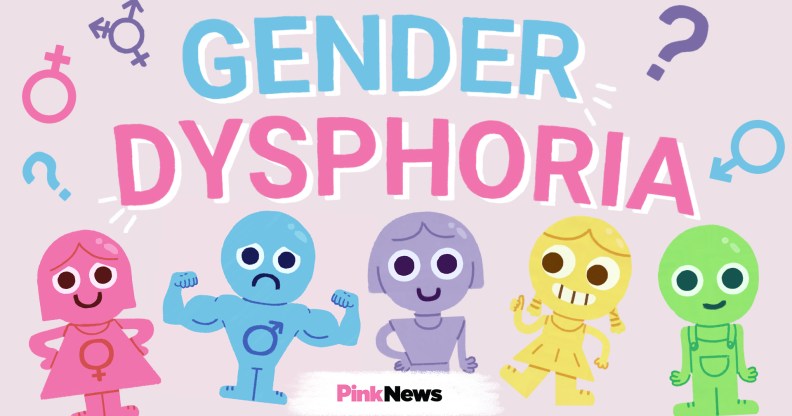What is gender dysphoria? Here’s what you need to know if you’re feeling uneasy with your gender

What is gender dysphoria? If you are feeling uncomfortable or uneasy with your gender identity – or if somebody you love is having these feelings – here’s what you need to know.
Gender dysphoria is a term you may have heard as transgender issues continue to be discussed more openly in society – or perhaps it’s something you want to know more about because of something you are currently going through yourself.
Whatever the reason, this handy guide is here to provide you with all the ins-and-outs, starting with the origin of the term itself along with a gender dysphoria definition.
Where does the word ‘dysphoria’ come from?
To understand what gender dysphoria is, it’s helpful to first understand its definition.
The word ‘dysphoria’ comes from the Greek word ‘δυσφορία’, which refers to a state of discomfort or unease.
Paired with ‘gender’ to create the phrase ‘gender dysphoria’, the term takes on a more nuanced meaning.
When referring to people who identify as transgender, gender dysphoria is when a person feels immense stress because their innate gender identity does not match up to the gender they were assigned at birth.
Trans men and women experience gender dysphoria, but it is also something that can be experienced by non-binary people as well.
What is gender dysphoria like?
Types of dysphoria can be broken down into classifiable subcategories, of which there are three.
Physical dysphoria
Physical dysphoria is when a trans person feels distress because their physical features don’t match up with the gender they truly are.
For example, transgender men often have dysphoria about their chests, as this physical trait does not align with their true male gender.
In many cases this can be fixed with a procedure called ‘top surgery’, which involves removing the breast tissue in order to create a more ‘masculine’–appearing chest.
Social dysphoria

Social dysphoria is when a trans person feels distress in social situations, due to worries of being misgendered.
Misgendering is when the wrong name or pronouns are used to refer to a trans person, eg using he/him pronouns for a trans woman who uses she/her pronouns, and using the name she was given at birth instead of her chosen name.
This can cause dysphoria to escalate severely, especially in social situations where a trans person is likely to already feel anxious and dysphoric. The act of using the wrong name for a transgender person is called ‘deadnaming’.
Using a person’s correct name and pronouns can do more than just alleviate dysphoria.
‘Gender euphoria’ is a term used to describe the great happiness and comfort a person experiences when they are able to live and present as their true gender identity – and this is accelerated when the correct name and pronouns are used by others.

Mental/emotional dysphoria
Mental or emotional dysphoria can be used to refer to the feelings a trans person experiences when dealing with worries about their transition, and the disconnect between their true gender and the gender they were assigned at birth.
This can sometimes be the most difficult type of dysphoria to deal with, because it’s something that lingers in the mind and can be almost impossible to escape if the person isn’t given the help they need in order to transition in a way that will ease their dysphoria.
Effects of gender dysphoria on mental well-being
If left untreated, gender dysphoria can manifest and lead to social isolation, poor mental health, and, in some cases, self-harm and suicide.
One way that some transgender people help lessen their dysphoria is by altering their appearance to more accurately reflect their true gender.
This can be done in a plethora of ways, including changing their hair, wearing more ‘gendered’ clothes, and binding/padding their chest — that last one is dependent on which gender a person was assigned at birth.
Gender dysphoria can also be alleviated by medically transitioning. This includes taking hormones such as testosterone (for trans men) or estrogen (for trans women), and having gender-affirming surgeries to allow an individual’s physical body to match their gender identity.
It’s important to note that while many transgender and non-binary people choose to change their appearance, take hormones or have surgery, it’s not a required part of being trans.
Studies have shown that alleviating dysphoria greatly improves the quality of life for transgender people, from allowing children to go on puberty blockers (which are reversible should the child change their mind) to having a passport or birth certificate with the correct gender marker on it.
There are qualified gender clinicians who are trained to help people who may be questioning their gender identity or struggling with issues such as gender dysphoria.
The UK has a handful of NHS gender clinics dedicated to helping members of the transgender community with figuring out who they are, and transitioning, if that’s something they require.
There are also private clinics that people can go through. These treatments can be costly but do allow patients to medically transition faster than they would via the public health service, if that is an option available to them.
Additionally, there are organisations such as Mermaids who exist to help young trans and gender-questioning people, along with their families who may also need support.

